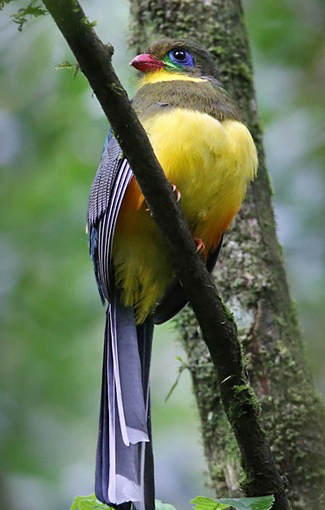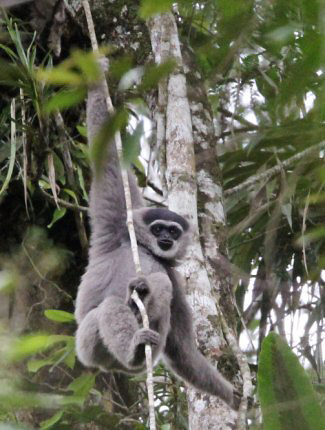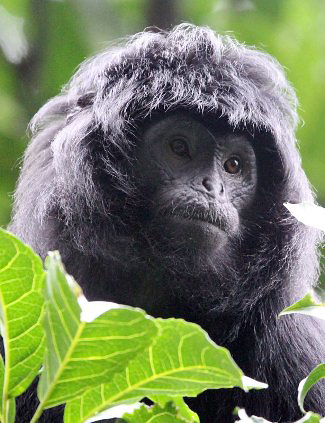

Javan Trogon in Gunung Gede-Pangrango National Park by Lars Petersson.
- 40 endemic birds, including Javan Frogmouth, Javan Trogon, Javan Broadbill, Javan Tesia and Javan Cochoa
- Many other near-endemics confined to Java, Sumatra and Bali, including Pink-headed Fruit-dove, Javan Kingfisher, Javan Banded Pitta, Sunda Blue Robin and Java Sparrow
- And some other spectacular birds such as Green Peafowl, Green Junglefowl, Christmas Frigatebird, Great-billed Heron and Blue Nuthatch
- As well as Javan Gibbon, a gibbon which is fairly easy to see
- And other mammals including Ebony and Grizzled Leaf Monkeys, Javanese Ferret Badger, Malay Stink Badger and Red Giant Flying Squirrel
- All somehow surviving on a very densely
populated island with steep forested
mountains and volcanoes
- The chances of seeing a Javan Rhinoceros are so slim that it hardly seems worth mentioning but hardcore wildlife travellers may wish to try by visiting Ujung Kulon National Park, accessible from Carita via an expensive five-hour-long speedboat trip. As far as it is known the entire world population – about 50 - of Javan Rhinoceroses now exists in Ujung Kulon.
- The numerous top wildlife destinations in the rest of Indonesia include Sumatra where Orang-utan, Siamang, White-handed Gibbon and endemic birds such as Graceful and Schneider's Pittas occur; Bali, just across the narrow Bali Strait to the east, where the very rare and very beautiful white Bali Starling is being reintroduced (not very successfully) to Bali Barat National Park which also supports Grey-rumped Myna, Great-billed Heron, Javan Plover and Javan Banded Pitta; Komodo, home of the huge Komodo Dragon; Sulawesi and Halmahera where the many endemic birds include Knobbed Hornbill, Maleo, Purple-bearded Bee-eater, Ivory-breasted Pitta and two birds-of-paradise; Wallace's Standardwing and Halmahera Paradise-crow; and the richest coral reefs on Earth, east of Sulawesi and west of West Papua where the spectacular endemic birds include Wilson's Bird-of-paradise.
Best Birds and other wildlife on Java
Birds
Endemics 40
White-faced (Grey-breasted) Partridge (east), Chestnut-bellied Partridge, Javan Frogmouth, Volcano Swiftlet, Javan Coucal, Javan Scops-owl, Javan
Hawk-eagle, Javan Trogon, Javan Blue-banded Kingfisher, Brown-throated Barbet, Red-crested (Grey-and-buff) Woodpecker, White-rumped (Pygmy) Woodpecker,
Javan Yellownape, Javan (Banded) Broadbill, Javan (Black-and-crimson) Oriole, Pied (White-browed) Shrike-babbler, Trilling (Chestnut-fronted)
Shrike-babbler, White-bellied Fantail, Rufous-tailed Fantail, Javan Green Magpie, Javan (Sunda) Bulbul, Javan (Sunda) Warbler, Javan Tesia, Pygmy Tit,
White-breasted Babbler, White-bibbed Babbler, Grey-cheeked Tit-babbler, Rufous-browed Babbler, Javan Fulvetta, Rufous-fronted Laughingthrush, Spotted
Crocias, Javan Pied Starling (central), Black-winged Myna, Grey-backed (Black-winged) Myna, Javan Cochoa, Indigo Flycatcher, Javan Shortwing, Javan
Leafbird, Javan Sunbird and White-flanked Sunbird.
Near-endemics
Java and Sumatra 6 Sumatran (Green-spectacled) Green-pigeon, Salvadori’s Nightjar, Javan Woodcock, Sunda Minivet, Sunda Blue Robin and Sunda Forktail.
Java, Sumatra and Bali 5 Pink-headed Fruit-dove, Bar-winged Prinia, Ruby-throated Bulbul, Orange-spotted Bulbul and Sangkar White-eye.
Java, Sumatra, Bali and Lombok (Lesser Sundas) 2 Cave Swiftlet and Javan Munia.
Java, Sumatra and Lesser Sundas (including Timor) 2 Javan Plover and Cerulean (Small Blue) Kingfisher.
Java, Sumatra and Sulawesi 1 Mountain Serin.
Java, Sumatra and Malay Peninsula 1 Waterfall Swift.
Java, Sumatra and Borneo 1 Scarlet-headed Flowerpecker.
Java, Sumatra, Borneo and Sulawesi 1 Black-backed Swamphen.
Java and Bali 17 Javan Owlet, Javan Kingfisher, Yellow-eared (Little) Barbet, Black-banded Barbet, Flame-fronted Barbet, Javan Flameback (east Java, also Kangean Island north of Bali), Yellow-throated Hanging-parrot, Javan Banded Pitta, Javan Grasshopper-warbler (east Java), Brown-cheeked Bulbul, Javan Grey-throated White-eye, Crescent-chested Babbler, Javan Myna, Javan Whistling-thrush, Streaky-breasted Spiderhunter, White-capped Munia and Java Sparrow.
Java, Bali and Lesser Sundas 7 Green Junglefowl, Sunda (Island) Collared-dove, Ruddy Cuckoo-dove, Dark-backed Imperial-pigeon, Rusty-breasted Whistler (east Java), Olive-backed Tailorbird and Blood-breasted Flowerpecker.
Java, Lesser Sundas and Sulawesi 1 White-shouldered Triller.
Java and Sulawesi (and satellites) 1 Grey-cheeked Green-pigeon.
Java and Borneo 3 Javan White-eye, Temminck’s Babbler and Javan (Hill) Blue-flycatcher.
Kangean, off northeast Java 1 Kangean Tit-babbler.
Other Specialities
Green Peafowl, Christmas Frigatebird, Great-billed Heron, Spotted Kestrel and Blue Nuthatch. Also a chance of Milky Stork, Rhinoceros Hornbill and Sunda
Thrush.
Others
Sunda Teal, Little Black Cormorant, Oriental Darter, Javan Pond-heron, Glossy Ibis, White-bellied Sea-eagle, Crested Serpent-eagle, Black Eagle,
Black-thighed Falconet, Great Crested and Lesser Crested Terns, Orange-breasted and Pink-necked Green-pigeons, Green and Pied Imperial-pigeons,
Chestnut-breasted Malkoha, Rusty-breasted Cuckoo, Sunda Scops-owl, Grey-rumped Treeswift, Crimson-winged and Sunda Pygmy Woodpeckers, Oriental Pied and
Wreathed Hornbills, White-breasted Woodswallow, Scarlet and Small Minivets, Long-tailed Shrike, Racquet-tailed Treepie, flycatchers, White-crowned
Forktail, Scaly (Horsfield's) Thrush, Chestnut-backed Scimitar-babbler, Eyebrowed Wren-babbler, Pygmy Cupwing, flowerpeckers and Little Spiderhunter.
Also a chance of Red Junglefowl, Black Bittern, Black-naped Fruit-dove, Orange-breasted Trogon, Banded Kingfisher and Tawny-breasted Parrotfinch.
Mammals
Javan Gibbon, Ebony (Javan Langur) and Grizzled (Sunda) Leaf Monkeys, Long-tailed (Crab-eating) Macaque, Banteng, Rusa (Timor Deer), Javanese Ferret
Badger, Sunda Stink Badger, Lesser Giant and Red Giant Flying Squirrels, Black Giant Squirrel, Common and Javan Palm Civets, Horsfield’s Tree Shrew and
Large Fruit Bat.
Reptiles and Amphibians
Green Turtle, Water Monitor and Malaysian Horned Frog (Gunung Gede-Pangrango NP).
Other Natural Wonders
Anak Krakatau (‘Child of Krakatau’)
This volcanic island emerged from the sea in the early 1930s but it is its predecessor which is more famous – the volcano which erupted in 1883,
producing one of the most powerful explosions in recorded history, heard 3540 km (2200 miles) away in central Australia!
Best Sites for Birds and other wildlife on Java

Javan Gibbon by Coke & Som Smith.
- Maura Angke, near Jakarta Javan Coucal and Bar-winged Prinia. Also a chance of Sunda Teal, Black Bittern, Black-winged Myna and Javan Munia.
- Pondok Bali, near Pamanukan (east of Jakarta) Javan Plover, Cerulean Kingfisher, Javan White-eye, and Javan and White-capped Munias.
- Boat trip to Pulau Rambut An island with an observation tower overlooking a waterbird colony containing Little Black Cormorants, Oriental Darters, herons, egrets and Glossy Ibises. Also Christmas Frigatebird, White-bellied Sea-eagle, Pied Imperial-pigeon and a chance of Milky Stork.
- Gunung Gede-Pangrango NP Javan Hawk-eagle, Pink-headed Fruit-dove, Yellow-throated Hanging-parrot, Sunda Scops-owl, Javan Owlet, Javan Frogmouth, Javan Trogon, Pied and Trilling Shrike-babblers, Rufous-tailed Fantail, Pygmy Tit, Javan Tesia, Sunda Blue Robin, Sunda Forktail, Javan Cochoa, Javan Whistling-thrush, Rufous-fronted Laughingthrush, Spotted Crocias, Javan Shortwing, White-flanked Sunbird, and Ebony and Grizzled Leaf Monkeys, as well as Rusty-breasted Cuckoo, Waterfall Swift, Blue Nuthatch, Chestnut-backed Scimitar-babbler, Eyebrowed Wren-babbler, Pygmy Cupwing and Streaky-breasted Spiderhunter. Also a chance of Chestnut-bellied Partridge, Javan Woodcock, Javan Kingfisher (Blue Lake), Scaly and Sunda Thrushes, Javan Gibbon (most likely on quieter western side of mountain out of Bodogol Research Station, along with leaf monkeys) and Javanese Ferret Badger.
- Gunung Halimun-Salak NP
Javan Hawk-eagle, Sumatran Green-pigeon, Javan Owlet, Javan Frogmouth, Waterfall Swift, Javan Trogon, Pied and Trilling Shrike-babblers, White-bellied Fantail, Pygmy Tit, Blue Nuthatch, Sunda Blue Robin, Sunda Forktail, Javan Cochoa, Javan Whistling-thrush, White-breasted Babbler, Spotted Crocias, Javan Sunbird, Streaky-breasted Spiderhunter, Javan Gibbon, Grizzled Leaf Monkey, Sunda Stink Badger, and Lesser Giant and Red Giant Flying Squirrels. - Carita/Curug Gendang Javan Frogmouth, Black-banded Barbet and Javan Banded Pitta. Also a chance of Black-naped Fruit-dove, Banded Kingfisher and Grey-cheeked Tit-babbler.
- Baluran NP Green Peafowl, Green Junglefowl, Great-billed Heron, Oriental Pied Hornbill, Crimson-winged Woodpecker, Javan Banded Pitta, Grey-cheeked Tit-babbler and Rusa. Also a chance of Black-winged Myna.
- Prambanan Temple Java Sparrow.
- Mount Ijen-Merapi-Maelang Reserve, near Banyuwangi White-faced Partridge, Javan Hawk-eagle, Pink-headed Fruit-dove, Yellow-throated Hanging-parrot, Black-banded Barbet, White-bellied Fantail, Javan Grasshopper-warbler, Scaly Thrush and White-flanked Sunbird.
- Alas Purwo NP Green Peafowl, Yellow-throated Hanging-parrot, Javan Kingfisher, Javan Banded Pitta, Black-winged and Javan Mynas, Banteng, Rusa (both at Sandengan feeding ground) and Ebony Leaf Monkey. Also a chance of Rhinoceros Hornbill.
- Meru Betiri NP Green Turtle (Sukamade camp) and Black-thighed Falconet. Also a chance of Orange-breasted Trogon.

Ebony Leaf Monkey by Coke & Som Smith.
Best Times for Birds and other wildlife on Java
The best time to be on Java to look for birds and other wildlife is April to October, which is usually the dry season, especially October when resident breeding birds are beginning to set up territories. The rainy season usually lasts from November to April and it usually rains a lot, especially in January-February.
Recommended Bird Books etc. for Java
Birds of the Indonesian Archipelago by J Eaton et al. Lynx Edicions, 2021 (Second Edition).
A Field Guide to the Birds of Borneo, Sumatra, Java and Bali by J MacKinnon. OUP, 1993.
A Field Guide to the Birds of Peninsular Malaysia and Singapore by A Jeyarajasingam. OUP, 2012. (Second Edition).
Birds of South-East Asia by C Robson. Helm, 2018. (Second Edition)
Birds of South-East Asia Concise Edition by C Robson. Helm, 2015.
A Field Guide to the Mammals of South-East Asia by C M Francis. New Holland Publishers, 2008.
A Field Guide to the Reptiles of South-East Asia by I Das. Bloomsbury, 2015.
Birding Indonesia edited by P Jepson and R Ounsted. Periplus Editions, 1997.
Where to watch birds in Asia by N Wheatley. Helm, 1996.
Don’t know which country/countries/regions to visit in Asia? Then it may be worth considering taking a look at this book, written by this website’s author. It is many years old of course but it still provides a starting point, an overview and a guiding light to the best birds and the best places to look for them in the region, and could save hours of searching for similar information on the internet. However, it is important to check more up-to-date sources for sites which have been opened up, sites and species which have been discovered, lodges that have been built etc. since the book was published.
Birding and Wildlife Trip Reports for Java
Many trip reports, some for Java, are posted on the websites listed here. On some of these websites some reports are independent and some are posted by tour companies who organize tours to Java. These tour companies and others also post their own reports on their websites, which are listed under 'Some Organized Tours to Java' below.
- The best website for trip reports is CloudBirders
- but these are also worth a look
- Birdtours
- Fatbirder
- Jon Hornbuckle
- Mammal Watching
Local bird and wildlife guides in Indonesia
The costs of organized tours partly reflect the quality of the tour leaders. Some leaders are certainly better than others and many companies claim their leaders are the best but even the best rely at least to some extent on the exceptional skills of the local guides they employ. If you are travelling independently, employing such local guides will greatly increase your chances of seeing the wildlife you wish to see.
Accommodation for birders on Java
Some Organized Tours for birds and other wildlife to Java
There are many tour companies who organize tours to see mammals, birds, other wildlife and other natural wonders. The cost of these tours vary considerably according to such variables as the airlines used, the number of days the tours last, the number of sites visited, the number of people in the group (an important consideration if you wish to see such wildlife as rainforest mammals and birds), the number of tour leaders, the standard of accommodation and transport, and the percentage profit the company hopes to make. Generally, where the number of days tours last and the number of sites visited are similar, the cheapest tours are those that use the cheapest airlines, accommodation and local transport, that have the largest groups with the least number of leaders, and that make the least amount of profit. The most expensive tours tend to be those which are exceptionally long, use the most expensive accommodation (ridiculously lavish in some cases, even for single nights) and which make the most profit. Some tour costs partly reflect the quality of the tour leaders. Some leaders are certainly better than others and many companies claim their leaders are the best but even the best rely at least to some extent on the exceptional skills of the local guides they employ.
While tour companies organize tours with set itineraries many also organize custom tours for individuals and private groups who instead of taking a tour with a set itinerary want to follow their own itinerary to suit their own personal tastes, whether it be mammals, birds, other wildlife, other natural wonders or even man-made attractions, or a mixture of them all. Many organized tours with set itineraries are also fast-paced and target as many species as possible, whether they are mammals, birds or other wildlife or everything, which usually leaves little time to enjoy the best sites and individual species, but on a custom tour those taking part can specify the pace and the sites and species they wish to concentrate on. Custom tours also suit people who like to travel with people they already know, rather than with a group of strangers, and people with partners with different interests. Individuals and small groups will almost certainly have to pay more than the price of an organized tour with a set itinerary but a large group of friends may be able to travel for less than the price quoted for a set tour.
Tour companies who run organized tours or can arrange custom tours to Java include the following.
- Birdquest
- Birdtour Asia
- Sultan Birding Tours
- Sultan Birding Tours based in Manado, North Sulawesi of Indonesia, specialized in operating bird photography, bird watching and wildlife trips within the island of Sulawesi, covering Tangkoko Nature Reserve, Gunung Mahawu Tomohon, Dumoga Bone National Park, Lore Lindu National Park, Halmahera and other birding destinations in Indonesia.
